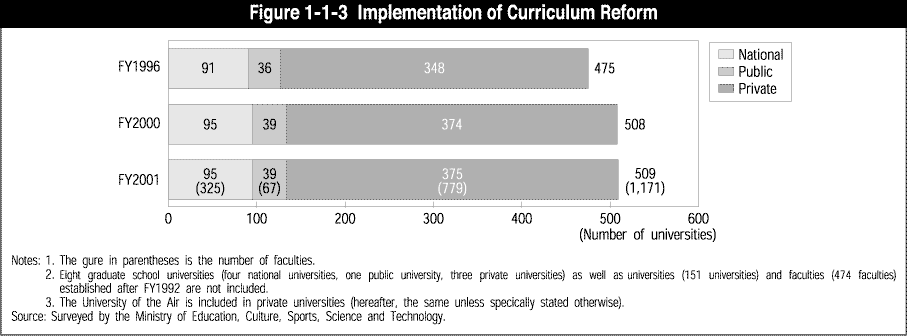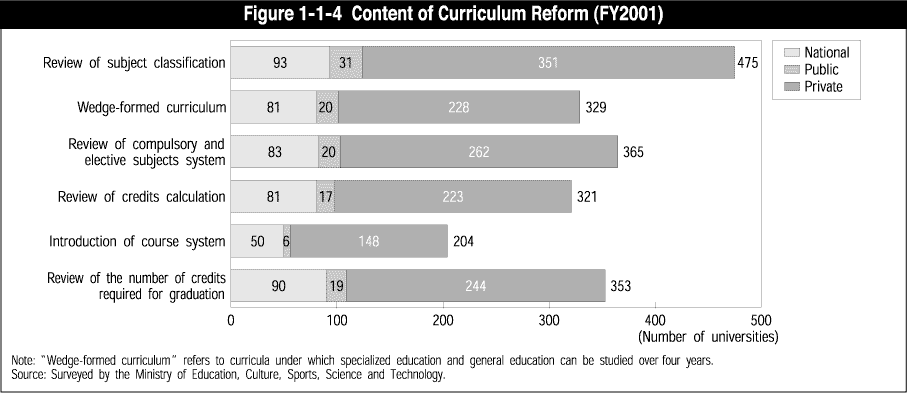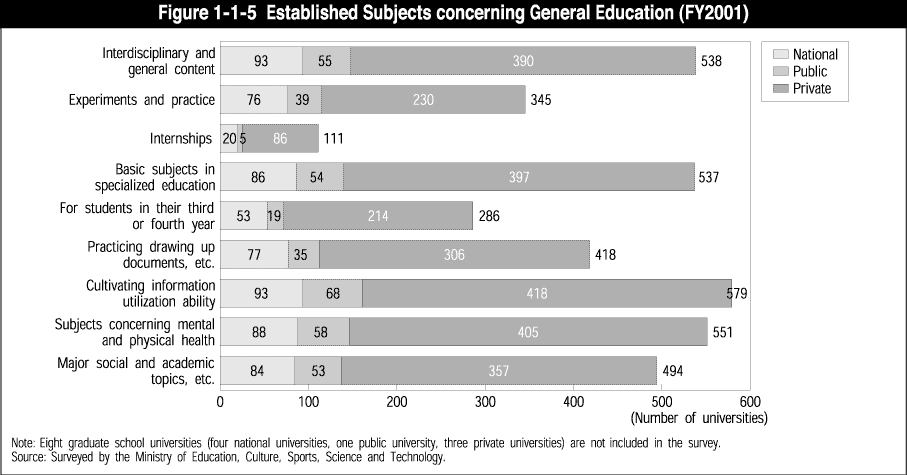| Home > Policy > White Paper, Notice, Announcement > White Paper > FY2003 White Paper on Education, Culture, Sports, Science and Technology >Part1 Chapter1 Section2.1 | ||
At universities, particularly at the undergraduate level, students are diversifying due to reasons such as a rise in the percentage of students proceeding to universities, a diversification in upper secondary education and an increase in adult and foreign students. Furthermore, against the background of the switch to a knowledge-based society, social demands on universities are undergoing enormous changes and diversification. It is necessary for universities to respond always accurately to these ongoing changes and to continue with flexible and mobile improvements to curricula and education methods. The Ministry of Education, Culture, Sports, Science and Technology is employing various methods to encourage improvements to education content, methods, etc. in universities.
There are two legal stipulations concerning university curricula provided in the Standards for the Establishment of Universities (Ordinance No. 28 of the Ministry of Education, 1956):


Most of these reforms, in principle, placed importance on general education and aimed to realize a systematic study of a subject over four years. It has been suggested, however, that due to a number of factors including the abolishing of departments with responsibility for implementing general education, general education is now being neglected more than ever. In recent years, as society has advanced and become more complicated, the relationships between the various elements in society have become stronger, and they have begun to create large ripple effects on one another. It has therefore become necessary to gain the capacity to make general decisions from many perspectives. For these reasons, when addressing curriculum reform, it is important to study the ideal curriculum, while making as a fundamental principle at the undergraduate level the cultivation of issue exploration ability (the ability to respond independently to changes, explore issues regarding one's own future, and make flexible and general decisions concerning those issues from a wide perspective), with a view to facilitating the connection between undergraduate education and upper secondary education by actions such as placing importance on general education, securing the organic cooperation of general education and specialized education, and placing importance on the basics and fundamentals in specialized education, as well as developing the ability to be active in international society ( Figure 1-1-5 ).

As part of undergraduate education, improvements to the content of education - curriculum reform - as well as innovative teaching methods and creative efforts for organized education in universities are important in carrying out education for ever more diverse students and achieving the education principles and targets of each university. With a view to guaranteeing the quality of graduating students, universities have made various efforts to develop responsible class management.
| 1) Responsible class management |
University education in Japan is fundamentally based on a credit system, with one credit class subject composed of content for which 45 hours of study is necessary. It is assumed that the amount of study required for one credit is not just time spent in the classroom, but also preparatory study and review carried out by the student before and after class. In this sense, independent study is required of the student. At the same time, it can be said that university educators must instruct students concerning the preparatory study and review they must carry out, for example, by indicating the literature the students must read for the class. Therefore, in each university, educators are required to carry out a planned class design by, for example, clearly explaining through the use of a syllabus, * etc., the education targets of each class subject and the teaching methods to be used to achieve the target, as well as the class plan for a one-year period. The educators are then required to convey in an understandable manner the purpose of the class subject to the students, and appropriately carry out guidance regarding study, including study outside the classroom. At the same time, through this process, it can be expected that independent efforts by the students to study will be stimulated. Universities drawing up syllabi that show detailed class plans are increasing year by year, and most universities now draw up syllabi ( Figure 1-1-6 ).

On the other hand, given the fact that one credit class subject is composed of content for which 45 hours of study is necessary, there is a built-in limit to the class subjects that can be studied within a fixed period. Therefore, in order to give substance to the credit system, it is important to prevent the registration of class subjects with a quantity of material too great to be studied in one year or one term, and at the same time to secure substantively the study amount in individual class subjects in line with the purposes of the credit system. To encourage these approaches, the Standards for the Establishment of Universities were. amended in 1999 and stipulations were put in place stating that universities had to make efforts to establish an upper limit to the number of credits that can be registered by students as one-year or one-term study subjects ( Figure 1-1-7 ).

| 2) Clear explanation of assessing academic achievement and implementing strict assessment for academic achievement |
In the previous assessment of universities, it was suggested that there have been cases where universities did not carry out appropriate graduation accreditation, and students therefore had not properly mastered the education content expected of a faculty graduate. Given that the role of universities is to cultivate human resources, universities have a social responsibility to give appropriate accreditation for course completion by students, and to secure the quality of students at the time of graduation.
With this in mind, for example, the following measures are being carried out by universities:


| 3) Faculty development |
In order to enhance university education, it is important for educators, who carry out direct educational activities for students, to make ongoing efforts to improve their own teaching abilities and to develop classes that stimulate enthusiasm for learning in their students. It is also important for educational organizations, in addition to individual educators, to clarify the educational principles and targets of the university as a whole or its departments and faculties, organize the curricula and establish class subjects in order to achieve that, and then have individual educators through a series of efforts carry out classes in line with these objectives.
As part of constructing this kind of organized education system, the number of universities implementing organized research and training with respect to those educational principles and targets, and education content and methods (faculty development) for all departments and faculties, is increasing. At MEXT, policies are being formulated to encourage active measures by universities. For example, in 1999, the Standards for the Establishment of Universities were amended and efforts to implement faculty development in universities were made compulsory.
In universities, a variety of measures are under way, such as educators observing each other's classes and then debating class content and methods, holding training seminars for new educators concerning class management methods, and establishing university-wide study organizations concerning class content and methods. The number of universities implementing these measures is increasing year by year, and awareness of faculty development is increasing ( Figure 1-1-10 ).

| * Syllabus |
A syllabus is a class plan showing the class subject name, name of the educator responsible for the class, course aim, course outline, content of each class, method of assessing academic achievement, textbook and reference literature, and other necessary requirements in relation to taking the course.
| * GPA (Grade Point Average) system |
Under the Grade Point Average System, academic achievement for each class subject is assessed one of five grades (A, B, C, D or E) and these grades are given grade points of 4, 3, 2, 1 and 0, respectively. The overall average of these points per credit is calculated. A student must achieve a grade point average of a certain level to graduate.
| * Semester system |
This is the class form under which there are multiple terms in one academic year. In contrast to the classification of first term and second term to characterize the yearlong system (a single subject is implemented over a period of one year), which was the standard in Japan, class subjects under the semester system are completed in each semester.
| Back To Top | MEXT HOME |